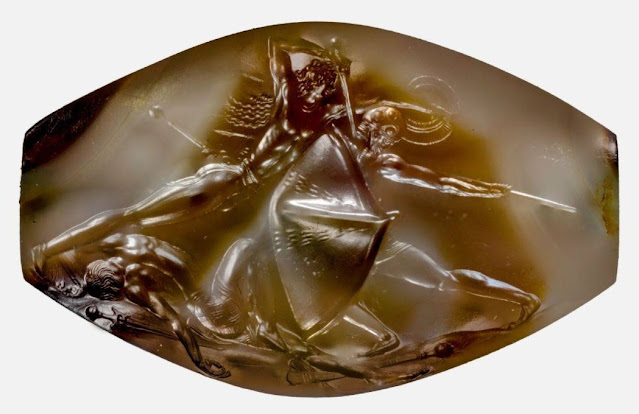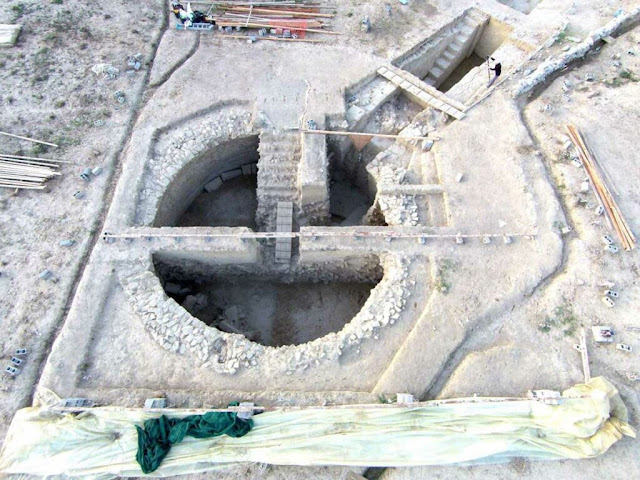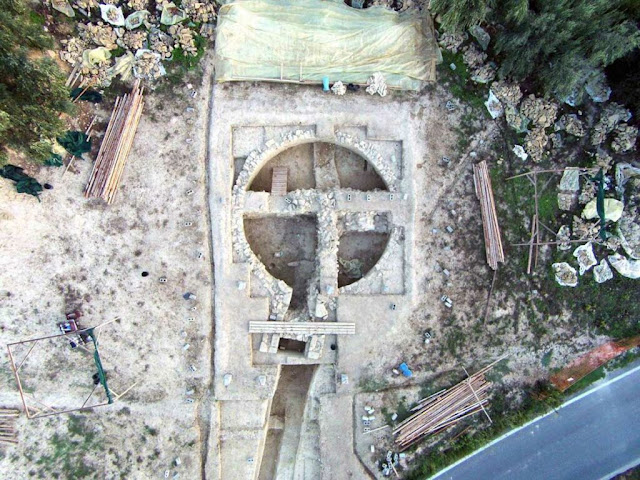The hill of Epano Eglianos is located just outside the village of Chora, 14km from Pylos, and hosts the "Palace of Nestor". The location was strategically chosen by the Mycenaean king, as it allowed him to freely supervise and control the kingdom as a whole and the entire sea area.
 |
| The Mycenaean cemetery in Ano Englianos of the town of Pylos [Credit: Ministry of Culture] |
The archaeological site at Epano Eglianos was discovered after excavations that began in 1912 and were completed after World War II. The palace is said to have been built around the 13th century BC by the mythical King Nestor, son of Neleas, who took part in the Trojan War with 90 ships. The palace itself is among the most important monuments of Mycenaean Greece, along with those of Mycenae and Tiryns in Argos. It is an ensemble in which a variety of buildings, including 105 ground floor apartments and other spaces, are integrated.
 |
| Plan of the Mycenaean palace and the cemetery [Credit: Ministry of Culture] |
The large rectangular "Throne Room" with the circular hearth, the wash room with the clay bath and the storerooms with the storage vessels are the most important part of the palace. The main buildings are the southwestern, central, northeastern and the wine storeroom. Frescoes depicting lyres and griffins (a symbol of the power of the Mycenaean kings of the region), floors with pictorial designs, an Archive Room where a thousand tablets inscribed in the Linear B script have been found.
 |
| The "Throne Room" and central hearth of "Nestor's Palace" [Credit: Ministry of Culture] |
In recent years significant findings from the Mycenaean cemetery have been brought to light by the archaeological research conducted by the University of Cincinnati, USA, with the archaeologists Jack Davis and Sharon Stoker, under the supervision of the Ephorate of Messinia/Ministry of Culture in collaboration with the American School of Archaeology in Athens. Certainly the research has focused since 2015 and to date on highlighting the significance of the adjacent cemetery to the palace.
Tholos Tomb IV, northeast of the Palace of Nestor
About 90 metres from the main gate, to the north-east, passing through an olive grove, one reaches a tholos tomb, whose vault was restored in 1957 by the Ministry of Culture. Although built with small stone slabs, it is nevertheless a large tomb, with a diameter of 9.35m. The vault had collapsed up to the top of the lintel and the tomb was filled with soil that was found completely disturbed, because it had apparently been robbed in antiquity.
 |
| Tholos Tomb IV [Credit: Ministry of Culture] |
But the looters had been unusually careless, leaving behind finds of great value in the tomb. Among the items found were many gold objects, including a royal seal with a representation of a winged griffin, two rings, jewellery in the shape of owls, and a shield-shaped pendant. Also 250 beads of amethyst and various other stones, and fragments of bronze weapons, etc. In this tholos tomb, the funerary customs were found to be identical to those of Mycenae, Thebes and other centres of the early Mycenaean period (16th century BC).
Tomb of the Griffin Warrior
In 2015, a few metres away from the palace, on the road to the mainland, two American archaeologists Jack Davis and Sharon Stoker made an unexpected discovery. Inside a stone-lined shaft grave, dating back to around 1500 BC, they found its entire contents. This intact tomb is thought to belong to a Mycenaean warrior who, in addition to himself, hid a priceless treasure in a wooden coffin. On his right side, weapons were placed and on his left side, jewels. Eight ornate ivory combs were found, evidence of trade relations with Africa, but also a mirror, since this was not only a rich and ambitious man, but above all an impressive man with long black curls, according to the visualisation provided by modern scientific methods.
 |
| The skeleton of an adult male stretched out on his back lay in the grave with weapons arranged to his left and a hoard of fine jewellery on his right [Credit: Denitsa Nonova] |
For three months archaeologists have been watching and agonising over a gold chain that the skeleton wore around its neck. Eighty centimetres long with a tremendously skilful elaborate chain, a design style that alludes to Minoan influence. A magnificent gold sword found next to the skeleton leaves some room for doubt as to whether it served as an actual weapon or had a symbolic function. A warrior with the exact same sword is depicted on a
seal stonethat he probably wore on his hand.
 |
| The tiny sealstone depicting warriors in battle measures just 1.4 inches across but contains incredible detail [Credit: University of Cincinnati] |
At the end of May 2018, two very important but also completely
unknown tombscame to light. These are two beehive-shaped burial structures named Tholos Tombs VI and VII. It is interesting to note that the paths leading to Tholos Tombs VI and VII run parallel to those of Tholos Tomb IV discovered by Blegen. It was obvious that along the road leading from the Acropolis and the "Palace of Nestor" to Chora Trifyllia, the most important cemetery from a spatial point of view had been built. All three vaulted tombs could have been in use when the griffin warrior died, which raises an important question: Why was he buried separately from the others and on his own?
In the case of Tholos Tomb VI, the space inside the chamber is quite large. The tomb is about 12 metres in diameter and its walls are preserved to a height of about 4.5 metres above the floor of the tomb. Tholos Tomb VI, according to the excavators' estimates contained approximately 1,000 cubic metres of soil and rock, deposited by landslides at various times following the collapse of the tomb's dome. However, there is considerable stratigraphy within the chamber. The phase during which the upper part of the chamber was inhabited in the Archaic-Classical period has been isolated and at a lower level, there appears to be a presence of the Post-Transitional Period, during the 11th and 10th centuries BC.
 |
| Tholos Tomb VI [Credit: Ministry of Culture] |
Tholos Tomb VII is significantly smaller with a diameter of only 8.5 metres, while its walls are only preserved to a height of about two metres. As far as their masonry is concerned, the walls of both tombs are constructed in a similar way with rough stones, while their entry ways or dromoi were earthen. However, one particular feature of Tholos Tomb VI remains unexplained: on the northeast and southeast sides of the chamber, carved stones were found lying on the floor of the tomb. The fact that they are so close to the walls reveals that they could not have fallen into the tomb from above. The stones had probably been transported from the Acropolis of the 'Palace of Nestor' having been salvaged from buildings that had been destroyed earlier.
What do these new observations mean?
Tholos Tomb IV, discovered by Blegen, appears to have been the first to be constructed and probably served as a magnet for later tombs. Anyone passing through the gate of the fortification wall surrounding the Acropolis during the early phase of the Late Bronze Age would have seen it in front of them. However, both the new vaulted tombs and the tomb of the griffin warrior were built later, in the 15th century BC, during the Late Helladic IIA period. The large chambers of the two tombs had remained inaccessible since antiquity, as they were protected by some 40,000 large-sized stones that had fallen into their interiors when their vaults collapsed. In both tombs, however, according to the Mycenaean custom of repeated interments in tombs, the remains of previous burials were periodically set aside while the grave goods that accompanied them were recycled and occasionally returned to the world of the living.
 |
| Tholos Tomb VII [Credit: Ministry of Culture] |
The overall character of the finds that remained in the new tombs and their dromoi are extremely similar to the chamber tombs that were revealed in Mycenae by the excavation activity of Christos Tsoundas in the 19th century, especially in terms of the style of jewellery and other decorations, while elements were also found that were absent in Pylos, and testify to links with the Near East and Egypt. Among the most exciting new finds are a gold ring depicting two cattle surrounded by barley stalks and a gold pendant depicting the head of the Egyptian goddess Hathor. This discovery is particularly interesting considering her role in Egypt as the patroness of the dead.
 |
| Gold pendant in the Tholos Tomb IV at Pylos featuring the likeness of Hathor, an Egyptian goddess who was a protector of the dead [Credit: UC Classics] |
In the past, Tholos Tomb IV was seen by many as the burial chamber of a family responsible for the creation of the Mycenaean state of Pylos. The picture now becomes much more complex. It is speculated that the griffin-warrior, in the light of so many expressions of both military and religious symbolism represented in the iconography of the objects buried with him, was a king of the early Mycenaean period, and that it is because of this hierarchy that the fact of his separate burial in a shaft grave, rather than the burial places of the Pylos kings and their families, is explained. These families had connections with Minoan Crete and built their houses on the Acropolis with carved stones influenced by the Minoan style and filled their tombs with products from Crete. Pylos, after the new finds, looks much more like Mycenae.
Thus the excavations of the University of Cincinnati enrich the archaeological data in the area of Pylos, providing valuable information about the channels of communication and trade with Minoan Crete, Egypt and the Near East in the early Mycenaean periods, especially before the great heyday of the 'Palace of Nestor'. In addition, new data and questions are raised about the political, social and religious status in western Messinia and the Peloponnese. The importance of this discovery lies in the fact that the belief in a clear separation between the cultures may not exist, since everything points to a cultural interaction between the Minoan and Mycenaean cultures over the centuries.
Author: Konstantinos Char. Tziambasis | Source: Anagnostis [trsl. TANN; December 23, 2021]
Support The Archaeology News Network with a small donation!

TANN
from Hacker News https://ift.tt/3zgoFXx

No comments:
Post a Comment
Note: Only a member of this blog may post a comment.